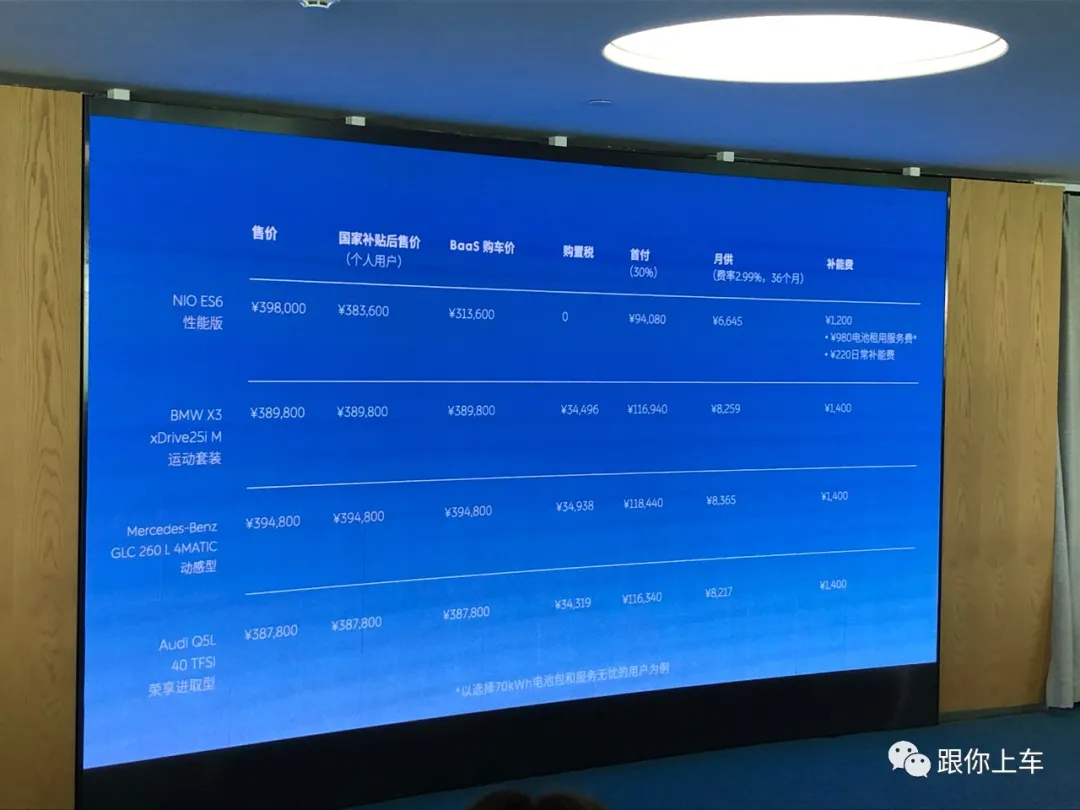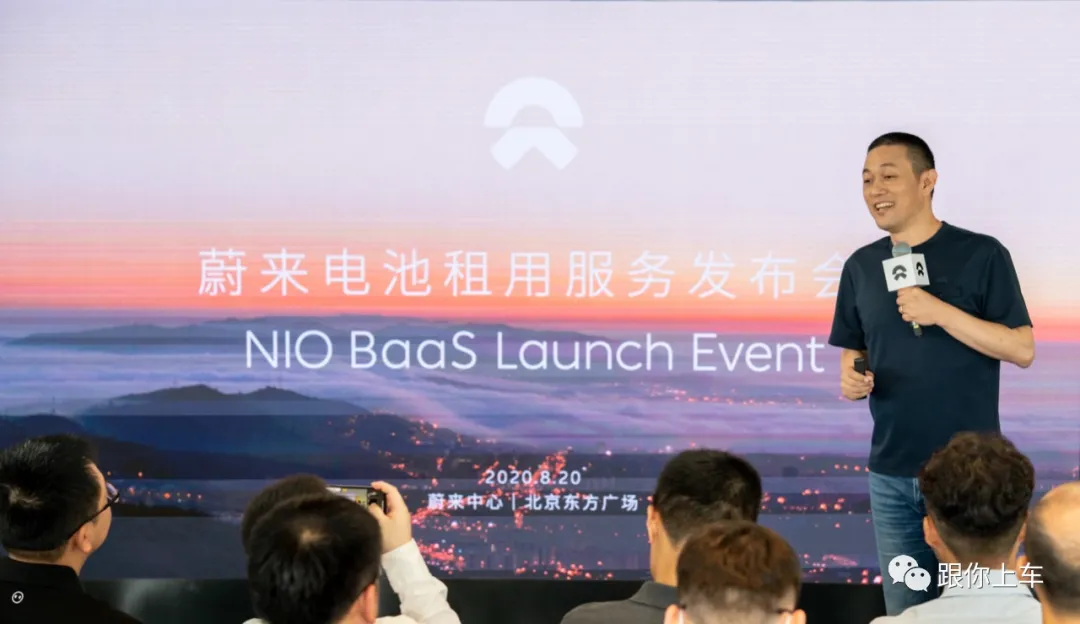NIO Officially Launches Battery-as-Service (BaaS)
I attended a NIO press conference at the Cow House on Chang’an Avenue this afternoon.
Unpretentious event, significant announcement.
NIO officially launched its Battery-as-a-Service (BaaS) subscription service. So, what is “BaaS”? In simple terms, it means that customers who purchase any of NIO’s car models can now choose to separate the car and battery purchases. Rather than buying the battery, users can lease it, obtaining usage rights.
Under this new subscription model, the price of the vehicles will decrease by 70,000 RMB, with batteries available for a monthly rent of 980 RMB.
Take NIO’s best-selling ES6 as an example. Previously, the performance version was priced at almost 400,000 RMB, but with BaaS, the price came down to 330,000 RMB. After subsidies, the actual price came in at just over 310,000 RMB, which can be financed through normal car loans.
What does this price mean?
In conclusion:
Since the introduction of the BaaS model, NIO’s product sales growth will inevitably increase, but it will take some time for customers to digest and adapt. In the long term, NIO will undoubtedly continue to grab market share from Tesla and traditional internal combustion engine vehicles.
In the pure electric vehicle field, the ES6’s most direct competitor is the Tesla Model 3. Although these two models are different types of cars, one being a sedan and the other an SUV, they are often the top two choices for many users.
What are the sticking points?
Although the ES6 has obvious advantages, such as larger space, better workmanship, and higher configuration, its drawbacks are also apparent.
For those who need a car, especially their first car, the ES6 is expensive. The price is almost 400,000 RMB, which is up to 60,000-70,000 RMB more expensive than China-made Model 3.
For those who care about brand image, NIO’s brand is not as famous as Tesla, and the company’s founder Li Bin is not as famous as Elon Musk, so NIO lacks some of the cool-factor.
After the introduction of BaaS, these two problems have been optimized.
The price of the ES6 has been reduced to almost the same level as the Model 3.
Although there is a monthly payment of around 1,000 RMB, the payment is still lower than the one-time 70,000 RMB payment, and the long-term and flexible lease plan for batteries, which may be more cost-effective than owning them, especially as battery upgrades and depreciation can have a significant impact.
Apart from the benefits to the vehicle purchase, the “BaaS” model embodies an innovative spirit, which includes Li Bin’s own story of renting rather than buying a house, even though he has already achieved financial freedom. NIO has become more interesting as a result, a feeling that is reminiscent of Tesla’s revolutionary impact.
As a user, owning a car that is easy, luxurious, and fashionable can bring tremendous psychological benefits, especially for luxury brands over 300,000 RMB.We can be sure that for a long time in the future, NIO will continue to expand the market with Tesla as the top two purely electric vehicle companies, and the “BaaS” model will definitely cut a portion of Tesla’s potential users who are hesitating to choose NIO.
2: Should the first car be a pure electric vehicle?
This is a bigger topic. After the “BaaS” model, the entry threshold for NIO has significantly reduced, which involves a part of the population that NIO wants to attract – first time car buyers.
Or to put it differently, if there is only one car in the family, should it be a pure electric vehicle? Should NIO be chosen?
Price is still a core factor. In the past, people have compared fuel vehicles and electric vehicles, and have always said that pure electric vehicles are cheaper to use but more expensive to purchase.
So the following chart can be carefully examined. After the “BaaS” model, the price of ES6 has already converged with or even become lower than that of fuel vehicles of the same class.

Let me talk about my own experience with using electric vehicles.
Wang and I have been trying to get a car plate in Beijing for many years, but have not yet succeeded. At the end of two years ago, I switched to new energy, and I am still in line now. So in Beijing, we rent a car with a license plate, and I have been driving my good friend’s 2018 GE3 recently.
It is a transitional product priced at just over 100,000 yuan, with a range of only 400km, and has already been eliminated from the mainstream pure electric vehicle lineup.
After driving for a period of time, the ease, quietness, performance, and space of driving a pure electric vehicle will make you think that you cannot go back. This is not a joke. You will understand once you have experienced it.
Last time I watched a video on Douyin made by Yan Yupeng, and he gave an interesting conclusion about how to choose between an electric vehicle and a fuel vehicle. He said that if it is below one million yuan, the experience of driving a pure electric vehicle completely surpasses that of driving a fuel vehicle.
Yes, fuel vehicles priced over one million yuan can be regarded as big toys. Looking at the trend of the future, they will be similar to instant cameras now, they are used to play with.
Going back to my GE3, I have two concerns:
The first is about charging. Actually, when I drive in the city, even if the range is only 400km, I’m not very anxious about the mileage. However, whenever it gets below 200km, I have an automatic thought of what time to take out to go charge and where to charge it. This feeling is not good, especially when I don’t have my own charging pile and the company does not have its own replenishment system. Every time I pass by Tesla’s supercharging or NIO’s battery swapping station, I genuinely envy them. This is what Li Xiang calls a core competitiveness.Two, there is concern about long-distance travel. This is mainly because the range of the 2018 GE3 is only 400km. I wanted to drive to Chongli to see the MIDI Music Festival from Beijing, but after calculating the distance of more than 300km round trip, I didn’t dare to go. However, this problem is basically non-existent in the new generation of pure electric vehicles. For short trips within 500km, such as around Beijing, the Yangtze River Delta, such as Shanghai and Hangzhou, and the Pearl River Delta, such as Guangzhou and Shenzhen, one charge is usually enough.
Therefore, can the first family car be electric? Of course, especially in big cities like Beijing, Shanghai, Guangzhou, and Shenzhen. It’s enough for daily city driving and there’s no license plate restriction. Occasionally, for small trips within 400 kilometers, it’s no problem to fully charge and return.
For trips that exceed 400km, you have to consider how many times a year you’ll take them. If it’s only once a year, such as returning to your Jiangsu hometown from Beijing, which is more than 1,000 kilometers away, and you have to spend some time charging or switching batteries on the road, turning a 12-hour trip into 16, it’s still acceptable.
For the vast majority of users, they really don’t take long trips several times a year. Of course, if you like to run long distances, say two or three times a month, then I suggest you not buy an electric car.
Li Bin said, “Welcome to consider a pure electric car as your first car, even if you don’t choose NIO.”
However, if you are buying a pure electric car now, your candidate list cannot avoid NIO.
Alright, that’s all for today.
This article is a translation by ChatGPT of a Chinese report from 42HOW. If you have any questions about it, please email bd@42how.com.
